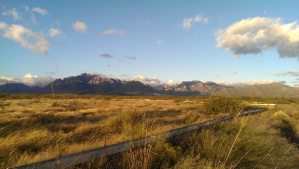Last weekend, I peeked at the naughty bits of dozens of rodents. I was in the San Simon Valley, outside Portal, Arizona, at the site of a long term ecological project there. (Incidentally, a fantastic stargazing site as well! Thanks to Alan Strauss and his friends for letting the mammal studying group join them and their telescopes for a little while.)
A student from Morgan Ernest’s lab was trapping rodents and tagging them, as she does every month. I had joined them to compare the rates at which motion detecting cameras caught animals with the rates that the live traps caught animals. For example, here is a video in which the camera recorded a visitor that did not get caught in the trap:
When animals are caught, they are measured and tagged. Rodents’ genitals become enlarged when they are open to mating, so researchers with a live mouse in hand can easily see if it is physically ready to be reproductively active. Typically, rodents reproduce primarily during the warm months, from March to October. Since this was mid-January, I was surprised to see many females pregnant or lactating as if having recently given birth, males with enlarged sex organs, and even recent signs of mating in a female kangaroo rat. No one has yet examined the data to see if this is really an unusual number of reproductively active animals, but it seemed high to me, though I am not an expert.
I had always thought the cold temperatures increased the risk of freezing to death, and that was why they bred in the summer months. But 2014 was the hottest year since record keeping began in 1880. Could the animals simply feel warm enough to be active and to give breeding a go?

Another important factor in both reproducing and staying warm is food energy. I recently went backpacking in southern Utah, hiking frequently through snow, and was amazed at how many calories I could – and needed to – eat to stay warm and active.

Substantial rains this summer at the Portal site made it the grassiest I have seen it in about five years. All that grass produces a lot of seeds, which many of these animals eat. Perhaps the larger amount of energy available is giving them the energy to go for it in January.

It is impossible to know if any one specific instance is a result of a long term trend in an otherwise variable system. Is the number of reproductively active rodents in January outside the typical range? Or even unusually high at all? Is it unusually high for grassy years? Is this one more small sign of larger changes in our climate?
If you have noticed small changes like this over the winter, I would be very interested to hear your stories.
